If skies are clear this Wednesday, you’ll see the full Moon. And not just any old full Moon, but the Blue Moon . . . the “true” Blue Moon!
If skies are clear for you on Wednesday, August 30th, you’ll want to take a look at the Moon. On that night, media outlets will tell you, you will be looking at a Blue Moon.
Only, it's not a real Blue Moon. Not only will it not actually be blue — it will be its usual dazzling, brilliant self — but it will match an outdated definition for which Sky & Telescope is to blame!
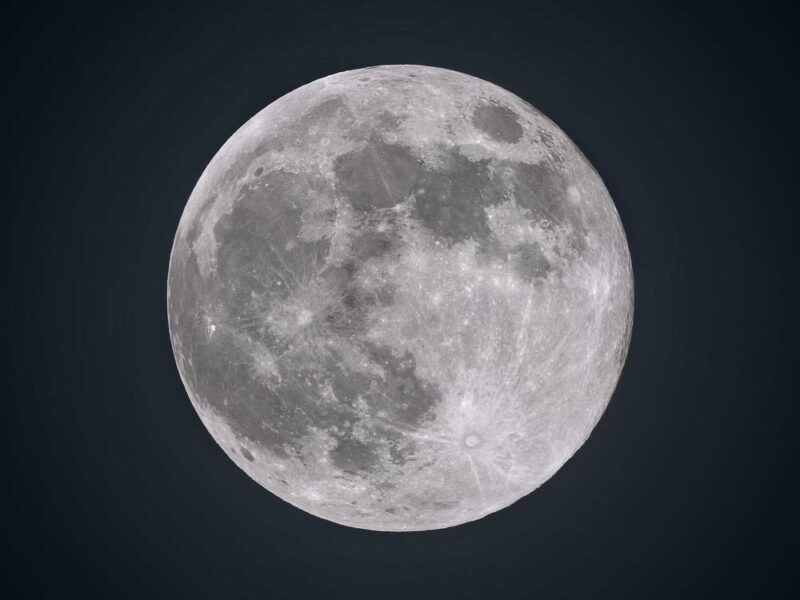
Gary Seronik
What do the words “Blue Moon” conjure for you? Maybe they remind you of something that happens infrequently, as in “once in a blue Moon.” For those of you with a melancholy bent, you might listen to songs that invoke the blue Moon as a symbol of sadness or loneliness. Elvis Presley famously implored the “Blue Moon of Kentucky” (written by bluegrass musician Bill Monroe) to keep on shining on the “one that’s gone and left me blue.”
The Moon does actually look blue on the rare occasion when either volcanic eruptions or significant forest fires send heaps of ash and soot particles into the atmosphere. In 1883 the Indonesian volcano Krakatoa blew its top — sunsets were green and the Moon was blue for several years after. And in 1951 massive forest fires in western Canada turned the Moon blue for viewers in northeastern North America. (I wonder if we’ll see that phenomenon this year, what with all the fires currently consuming the Northwest.)

Taro Taylor / CC BY 2.0
But maybe you’re casting your mind back to the last time the Moon was full for the second time that month. That’s generally given as the technical definition of the phrase “Blue Moon.” But it’s not correct. The original definition has gone astray . . . and Sky & Telescope is to blame!
The True Blue Moon
Once upon a time, the Maine Farmers’ Almanac — that august publication that has provided long-term weather forecasts for the U.S. and Canada since 1818 — regularly cataloged “blue Moons.” But these weren’t the second-in-a-month full Moons (like last Halloween’s). Instead, they’re the third full Moon in a season that has four.
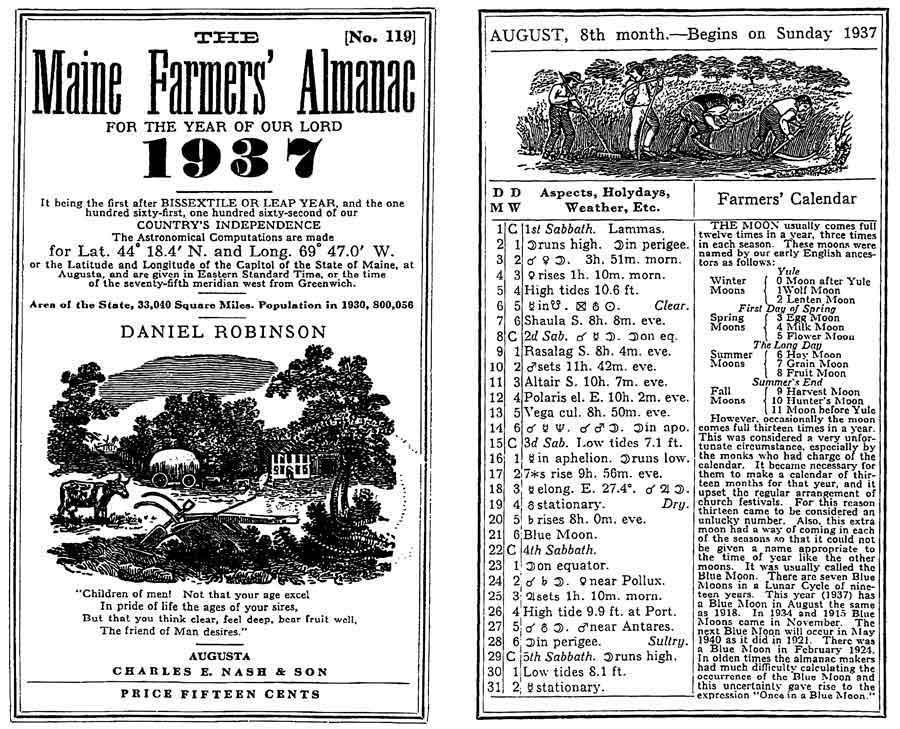
Maine State Library
The Maine Farmers’ Almanac uses the tropical year, which is measured from one winter solstice to the next). The majority of tropical years have 12 full Moons — or three per season. Many cultures around the world assign names to full Moons that reflect the time of year. Think of the Snow Moon in February, or June’s Strawberry Moon, or the Harvest Moon, the full Moon closest to the autumn equinox (in the Northern Hemisphere). But every now and then a tropical year will have 13 full Moons — this means that one of the four seasons will be graced with four full Moons. Thus, naming the third full moon of a season “Blue” ensures that the other full Moons aren’t out of synch with their names.
So how did the “Blue Moon” adopt the “second-in-a-month” reference?
S&T Blooper
Way back in 1943, when Sky & Telescope was still a fledgling magazine in only its second full year of operation, page 17 of the July issue featured a question-and-answer column. In it, Laurence J. Lafleur of Antioch College, Ohio, referred to the 1937 Maine Farmers’ Almanac when discussing Blue Moons and wrote, “occasionally the moon comes full thirteen times in a year.” But he never explicitly stated that the Blue Moon was the second full Moon of the month.
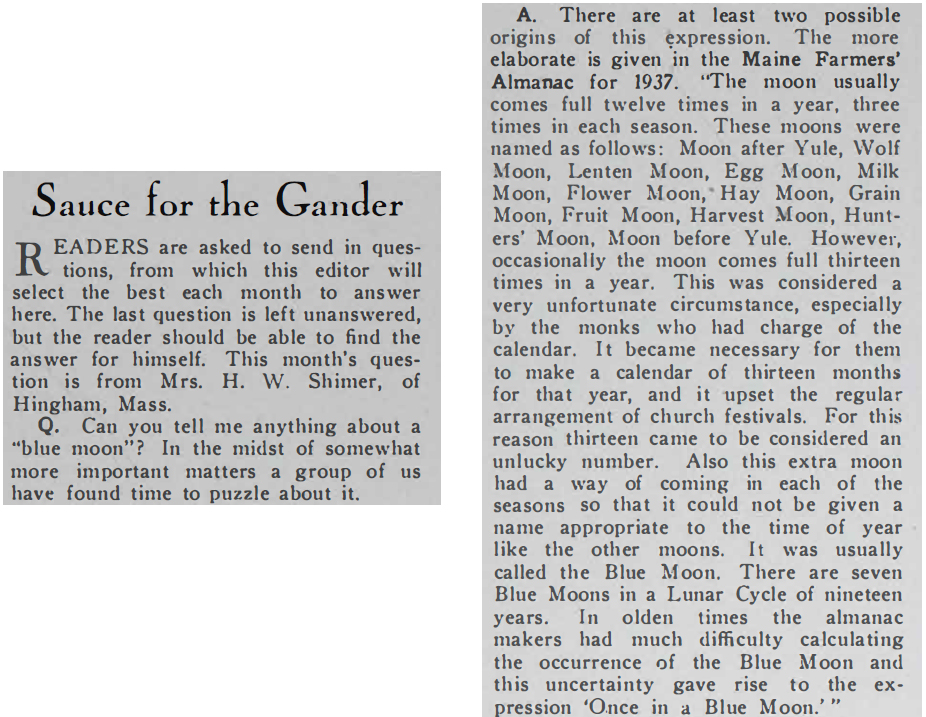
Sky & Telescope
Fast-forward to 1946 and page 3 of the March issue of Sky & Telescope. In an article entitled “Once in a Blue Moon,” amateur astronomer James Hugh Pruett referred to the 1937 Maine Farmers’ Almanac and Lafleur’s column. He writes, “But seven times in 19 years there were — and still are — 13 full moons in a year. This gives 11 months with one full moon each and one with two. This second in a month, so I interpret it, was called Blue Moon . . . “
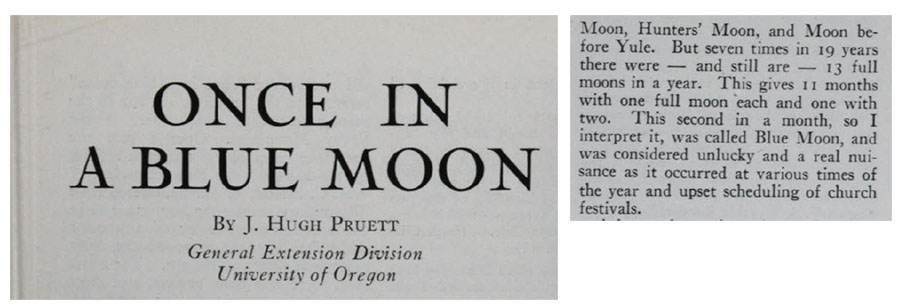
Sky & Telescope
By the May 1950 issue of Sky & Telescope, a subsection of the “Observer’s Page” on page 176 features “‘Blue’ Moons in May” wherein Henry Porter Trefethen — the editor of the 1937 Maine Farmers’ Almanac no less — answers a reader’s question on months with two full Moons and provides a list that goes back to 1836. And there you have it. That column likely cemented the association between “Blue Moon” with the second full Moon in a month. (Trefethen himself never linked the two — the “’Blue’ Moons” headline was added after the fact.)
Canadian folklorist Philip Hiscock first became aware of the phrase in 1988 when the month of May that year had a second full Moon. This event sparked the public’s imagination and Hiscock’s curiosity and so he decided to investigate the origin of the phrase. Besides the references mentioned above, Hiscock noted that a popular radio program broadcast on January 31, 1980, was likely responsible for propelling the second-in-a-month definition into public consciousness. He also dug up other curiosities, such as that the popular boardgame Trivial Pursuit incorporated the question “What’s a second full moon in a month called?” in its 1986 edition (if you happen to have the March 1999 issue of Sky & Telescope lying around, turn to page 52 for this story). Texas astronomer-historian Donald W. Olson, along with research librarian Margaret Vaverek at Texas State University, worked with the magazine’s editors at the time to figure out the origin of the mistake, and how the two-full-Moons-in-a-month meaning spread into the English language (see the May 1999 issue, page 36).
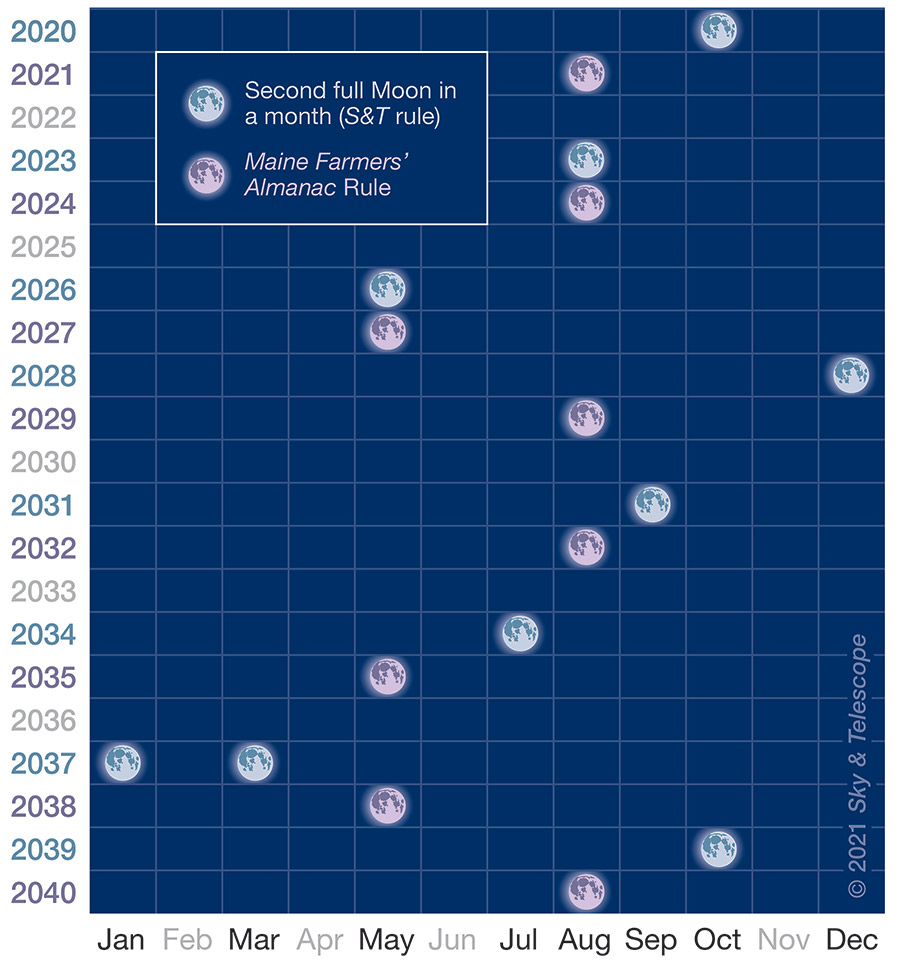
Sky & Telescope
Hopefully skies will be clear this week, so we can all celebrate August 30th's Sturgeon Moon as well as an S&T Blue Moon — but we'll have to wait until August next year for the next “true” Blue Moon.
Here’s something for the grownups: While waiting to feast your eyes on that dazzling orb this August 30th, why don’t you wet your whistle with a Blue Moon cocktail. Fill a tall glass with ice, splash in four parts gin and one part blue curaçao, and add a twist of lemon. Cheers!
See What is a Blue Moon in Astronomy? for more details on the way the Farmers’ Almanac assigns the blue Moon status.
 13
13









Comments
Yaron Sheffer
August 20, 2021 at 1:20 pm
Meh? Too much ado about nothing? This topic does not befit an astronomy magazine, if only because it relies on that dubious publication “the farmers almanach”, the weather predictions of which are in perennial disagreement with the weather that actually happens in the real world. The FA is more closely aligned with astrology, not astronomy.
You must be logged in to post a comment.
Warren-Odom
August 20, 2021 at 7:24 pm
If we got rid of all terminology, or all articles that discussed the same, that is based in traditional lore, astrology, etc., we'd have to eliminate the names of all the planets, and most of the constellations as well.
You must be logged in to post a comment.
Peter Wilson
August 20, 2021 at 1:22 pm
With a telescope, the Moon can be seen to be literally blue, twice a month. Try this: 3 - 5 days before or after it's new, observe the crescent Moon under medium to high power. Now, move the sunlit part entirely out of the field-of-view. The dim part, lit by Earth-shine, will appear blue!
You must be logged in to post a comment.
Curt Renz
August 20, 2021 at 4:16 pm
It's not a "true" blue Moon unless its color turns blue.
Nonsense in almanacs does not make it "true". Now modern publications like "Sky & Telescope" just use it as "click-bait".
I wish mention of this actually occurred just "once in a blue Moon".
You must be logged in to post a comment.
Science
August 20, 2021 at 5:13 pm
Excellent article, I love learning, or learning more about, bits of trivia. A little hubris is good. It helps those of us in the scientific community remember not to keep our noses in the air, lest we drown in our self righteousness. I'm going to share this with my astronomy club at tonight's meeting.
You must be logged in to post a comment.
Charles-Keller
August 20, 2021 at 5:52 pm
A fine article. I appreciate the history and sky lore portion of S&T. Good stuff!
You must be logged in to post a comment.
Mike Hanafin
August 20, 2021 at 8:09 pm
Borderline "astronomy", but better than most stories I am seeing being shared, with photos of blue-tinted moons and no explanation of the science or actual astronomy. C-
You must be logged in to post a comment.
DSailing
August 21, 2021 at 2:51 pm
First I would like to say this is a great article. However it does create a question about something related to the subject.
This Year does not have 13 Moons in any time-zone. However that is not a problem because the definition applies to tropical-year. The Winter-Solstice occurred Dec 21 2020 at 10:02 UTC and the first Full-Moon after that was Dec 30 2020 03:28 UTC giving 13 full-moons in the tropical-year.
The problem I have is when I try to apply names to each Full-Moon. It seems to me that the Dec 30th Full-Moon should be titled the Wolf Moon. However everything on the internet says that the Jan 28 2021 19:16 UTC Full-Moon is the Wolf Moon. Some web pages directly say that Jan 28 2021 is the Wolf Moon and other state that the Wolf Moon is always in January.
That creates a problem. If moon names are attached to a specific month, then how are months with two full moons handled without the new definition of a Blue-Moon? Since the names are based on Native American custom, how did they know about Gregorian calendar months before Europeans got here?
Is it possible that every web site on the internet has the Full-Moon names this year before the August moon wrong or am I just missing something?
You must be logged in to post a comment.
misha17
August 29, 2023 at 4:28 pm
Back in May, we had a "Black Moon", the 3rd New Moon in a season with 4 new moons instead of the usual 3. I believe the Farmer's Almanac came up with this term too.
An S&T "Blue Moon" will always occur about 3 months after a "Black Moon"
1.Season begin between the 20th or 21st of a month, so the "Black Moon" will occur a day or so earlier in the month preceding the start of a season in order to fit in a 4th new moon before the next season begins.
In 2023 the "Black Moon" was on May 19th, ahead of the solstice on June 21st.
2. Full moons occur about 15 days after a New Moon, so the Full Moon following a "Black Moon" around on the 3rd or 4th day of the month when a season occurs.
In 2023, the Full Moon following the "Black Moon" occurred on June 3rd.
3. Full Moons occur apart 29 1/5 days apart (a "synodic period", or "lunation"), and most months have 30 or 31 days, so full moons occur a day or two earlier each month. Also, 2 lunations equals about 59 days, and most month-pairs have 61 days (31+30 days or 30+31 days), so after 2 lunations the Full Moon occurs 2 days earlier in the month.
A little math show that after 2 or months after a Black Moon, the Full Moon has "crept up" to the beginning of the month, leaving enough days at the end of the month for a second Full Moon to occur in the same month (the "S&T Rule" for a Blue Moon).
You must be logged in to post a comment.
Jeff
August 30, 2023 at 6:27 pm
I really love S&T magazine. You have some great articles, and contributors.
However, please stop pandering to the banality of the rest of the media by promoting both this blue Moon and Supermoon nonsense. Neither of these terms are of benefit to astronomy, amateur or otherwise. In addition, your article couldn't have made the whole subject more confusing if it had tried; particularly with the graphic comparing the 'blooper' S&T rule and the FA rule.
The term Supermoon is also ridiculous. I'd defy anyone to step outside on any night of a given full Moon (without the benefit of prior knowledge) and declare from observation alone that a Moon is slightly larger in apparent size than any other month. All this does is create media attention and disappoint the casual observer. It's also a particularly annoying reference given the known optical illusion effect that makes the Moon appear larger when closer to the horizon anyway. The Moon hovering over the horizon could always be referred to as a Supermoon, when compared to how it appears at it's highest point a few hours later.
You must be logged in to post a comment.
Tom Hoffelder
September 2, 2023 at 10:03 am
Especially the super silly super psychobabble super moon (created by an astrologer)! The apparent size of the moon in the sky is a pea. A few percent change in the size of a pea is still a pea.
You must be logged in to post a comment.
Yaron Sheffer
September 10, 2023 at 12:43 pm
Based on the info in the title and subtitle of this article, Wednesday is now part of the weekend. If only this was true in real life…! Sadly, only once in a blue Moon 😉
To me, the phrase “Once in a blue Moon” has the exact same meaning as “When Hell freezes over”. These are impossible “events”, not to be taken as real-life Astronomical phenomena.
You must be logged in to post a comment.
Monica Young
September 11, 2023 at 3:07 pm
Thanks for your note, I've fixed the teaser.
You must be logged in to post a comment.
You must be logged in to post a comment.